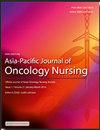Effects of Swanson theory-based auricular acupressure on chemotherapy-induced peripheral neuropathy, and broader health-related outcomes in patients with breast cancer: A randomized controlled trial
IF 2.8
3区 医学
Q1 NURSING
引用次数: 0
Abstract
Objective
Chemotherapy-induced peripheral neuropathy (CIPN) is common in patients with breast cancer who received taxane-based chemotherapy. While auricular acupressure has shown promise in symptom management, its effects within a caring framework remain underexplored. This study aims to examine the effects of Swanson theory-based auricular acupressure on CIPN and broader health-related outcomes (e.g., sleep and quality of life) and the potential mediating role of inflammatory biomarkers.
Methods
Seventy-four participants with breast cancer were recruited with 1:1 random assignment in intervention group and control group. Participants in the intervention group were instructed by nurses to do Swanson theory-based auricular acupressure during the 6 cycles of chemotherapy. Auricular acupressure was applied to10 ear points with each of them evenly for 1–2 minutes at a time and 3–5 times a day according to their feeling of discomfort. CIPN symptoms, sleep quality, inflammatory biomarkers, quality of life and patient-reported nurse-patient relationship were measured. Two-factor repeated measures analysis of variance was used to assess differential change in these outcomes between the two groups over time.
Results
The levels of inflammatory biomarkers decreased over time in both groups. Compared to the control group, the intervention group experienced significantly larger reduction in Tumor Abnormal Protein level (P < 0.001), smaller increases in CIPN symptom severity (P < 0.001), improved sleep quality (P < 0.001), and higher levels of trust in nurses (P < 0.001) across chemotherapy cycles.
Conclusions
Swanson theory-based auricular acupressure may have a potential benefit to mitigate the worsening of CIPN symptoms, improve sleep and quality of life, reduce inflammatory biomarkers, and enhance the nurse-patient relationship during chemotherapy. These findings support the integration of auricular acupressure within holistic cancer care, highlighting the value of compassionate, theory-driven nursing interventions. Further large-scale studies are recommended to confirm these outcomes and explore underlying mechanisms.
Trial registration
This study was registered in the National Health Security Information Platform (Medical Research Registration and Information System, https://www.medicalresearch.org.cn/) (MR-14-24-054013).
基于Swanson理论的耳穴按压对乳腺癌患者化疗诱导的周围神经病变和更广泛的健康相关结局的影响:一项随机对照试验
目的化疗引起的周围神经病变(CIPN)在接受紫杉烷类化疗的乳腺癌患者中很常见。虽然耳穴按压在症状管理方面显示出希望,但其在护理框架内的效果仍未得到充分探讨。本研究旨在研究基于Swanson理论的耳穴按压对CIPN和更广泛的健康相关结果(如睡眠和生活质量)的影响,以及炎症生物标志物的潜在介导作用。方法74例乳腺癌患者按1:1随机分配分为干预组和对照组。干预组在护士指导下,在6个化疗周期内进行Swanson理论耳穴按压。根据感觉不适情况,均匀按压10个耳穴,每次1 ~ 2分钟,每天3 ~ 5次。测量CIPN症状、睡眠质量、炎症生物标志物、生活质量和患者报告的护患关系。采用双因素重复测量方差分析来评估两组间这些结果随时间的差异变化。结果两组患者炎症标志物水平均随时间降低。与对照组相比,干预组肿瘤异常蛋白水平(P <;0.001), CIPN症状严重程度的增加较小(P <;0.001),改善睡眠质量(P <;0.001),对护士的信任度较高(P <;0.001)。结论基于swanson理论的耳穴按压可能在缓解CIPN症状恶化、改善睡眠和生活质量、降低炎症生物标志物、改善化疗期间护患关系等方面具有潜在的益处。这些发现支持在整体癌症护理中整合耳穴按摩,突出了富有同情心,理论驱动的护理干预的价值。建议进一步的大规模研究来证实这些结果并探索潜在的机制。本研究已在国家卫生安全信息平台(医学研究注册与信息系统,https://www.medicalresearch.org.cn/)注册(MR-14-24-054013)。
本文章由计算机程序翻译,如有差异,请以英文原文为准。
求助全文
约1分钟内获得全文
求助全文
来源期刊

Asia-Pacific Journal of Oncology Nursing
Multiple-
CiteScore
2.80
自引率
11.10%
发文量
136
审稿时长
31 days
 求助内容:
求助内容: 应助结果提醒方式:
应助结果提醒方式:


